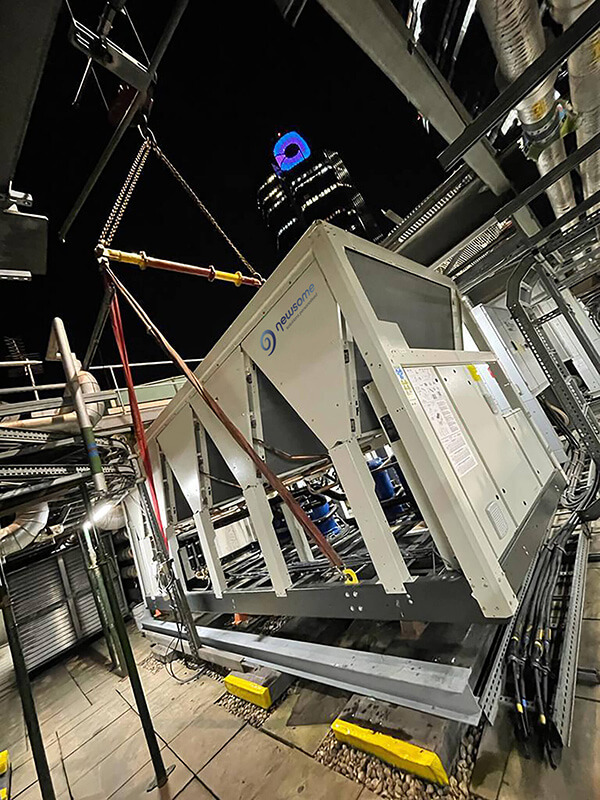Client – Health Club
Location – London
Project value range– £150,000-£200,000
Project completion – March 2023
Project duration –12 months (including the design phase, supply, and installation)
Project overview – Full turnkey 640kW cooling solution installation including concepts, system design, equipment supply, commissioning, maintenance, and traffic/utility management from concept to completion.
Current situation/problems/challenges
The existing McQuay ALS 178.2 air cooled chiller was inefficient compared to new chillers and the performance was significantly affected further as ambient temperatures reached 35°.
As the frequency of heatwaves increase and the temperatures within our city centres often exceed 30 degrees Centigrade, this can put additional strain on the performance of commercial chillers and air conditioning systems. The chiller used on-site at the health club was being affected by performance issues as ambient temperatures climbed towards 30 degrees. With rising energy prices, this loss of performance was incurring significant additional energy costs. These additional energy costs were estimated at approximately £15,000 per year.
Current legislation also states that refrigerants with high Global Warming Potential (GWP) should be phased down with the more damaging refrigerants phased out of manufacture. The existing chiller contained a refrigerant with a high GWP that would be phased out, putting the longer-term use of the chiller at risk of obsolescence.
Project Solution
The solution implemented by Newsome was to install a new, energy-efficient CGAF 180 SE/SN air cooled chiller capable of dissipating a thermal load of 630kW with supporting adiabatic cooling functionality designed to increase overall system efficiency, reduce energy consumption and running costs. At Eurovent Design operating conditions, the proposed CGAF 180 SE SN air cooled chiller is 18% more energy efficient than the incumbent McQuay chillers.
The chiller chosen also incorporated an efficient refrigerant with a low GWP – the refrigerant used in the chiller is R454b. This is a low GWP refrigerant not subject to the same phase-down regulations and is considered a long-term alternative to R410a providing a GWP reduction of 76% compared to the existing R410a and also 34% lower than the alternative R32 refrigerants.
To ensure that the unit could continue to operate in dry bulb ambient air temperatures greater than 35°C, Newsome implemented an adiabatic spray system. The adiabatic spray system ensured that incoming air onto the condensers never exceeded 35°C. Alternatively, the adiabatic sprays can be set at a lower incoming air temperature to enhance further the chiller efficiencies.

Project Implementation
Newsome provided a full turnkey solution for this chiller replacement project including the following mechanical, electrical, and technical implementation.
Newsome removed the existing McQuay ALS 178.2 air cooled chiller mechanically and electrically from its present location seated upon anti-vibration mounts and raised support pads. Once isolated electrically, mechanically, and drained of fluid, the chiller was prepared for removal. Work was completed on a CPA contract lift basis across a weekend and outside of normal working hours to minimise local disruption due to road closures. Once the existing chiller was removed, the new chiller was positioned into the space vacated and then both electrically and mechanically engaged into the existing cooling circuit. To ensure there were no issues with the weight loading points on the unit versus the removed chiller, Newsome positioned steel supports onto the existing pads prior to positioning the new chiller.
Newsome also supplied and installed stainless steel pipework to connect the new chiller to the existing circuit. The pipework and associated valves and fittings were supported from both ground level and the building structure and were secured via pipe clips, screwed rods, and fabricated bracketry at the recommended intervals as required by British Standards and CIBSE guidelines.
Newsome also provided the electrical works including isolating and disconnecting the existing six 185mm single core AWA cables, supplying and installing a fabricated Unistrut steel frame on the ends of the existing 185mm single core cables, and providing 3 lengths of cable containment installed on suitable steel brackets fixed to the floor in the agreed locations. Newsome was also responsible for supplying and installing a steel 630Amp switched fused isolator, new 500Amp fuses installed in the new switched fused isolator and all associated electrical work resulting in the issue of a NICEIC test certificate.

TThermal insulation was also provided onto all new pipework. All valves, strainers, and flanges which required periodic attention were fitted with pre-insulated purpose-designed and manufactured boxes or bags and fitted with toggle clips for ease of removal. All insulation was identified in accordance with BS1710, and external insulation was weatherproofed with Aluminium Stucco cladding.
Newsome also supplied and installed an adiabatic spray kit connected to the chiller comprising the following key components: Double Check Valve, Pressure Gauge, Fill Valve, Vent, Drain and Spray Solenoid Valves, Inlet Y Strainer, Spray Booster Pump, Pressure Switch, UV Treatment System, Pressure Regulator, and full Control Panel.
Once in place, the Newsome chiller service team commissioned the new chiller. There was no requirement for the Virgin Active site team to assist in any aspect of the turnkey solution or site preparation, except for roof access approvals from the landlord and review of the supplied RAMs. As part of the project works Newsome Ltd decommissioned the existing chiller and ethically disposed of all equipment, components, and refrigerant.
Conclusion and Results
The supply and installation were a huge success completed on time, as quoted, with minimum disruption and little involvement required from the client.
Specifically, the project provided a future-proof cooling solution due to the low GWP-specified refrigerant. The system was also more efficient as a result of not only the more efficient chiller supplied but also the added cooling potential provided by the adiabatic spray kit. CO2 emissions will be reduced by 21 tonnes each year with a full project payback in under 6 years.

In Numbers:
- GWP of the refrigerant used was reduced by 76%
- Energy saving of the new chiller approximately 10% = £14,830
- Energy saving attributed to the adiabatic spray kit approximately 10% = £14,465
- Combined annual energy saving of the new chiller and adiabatic spray kit combined approximately £29,295
- Annual CO2 emissions reduced by 21 Tonnes (9%)
- Project payback less than 6 years

